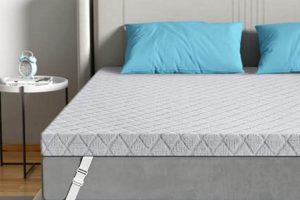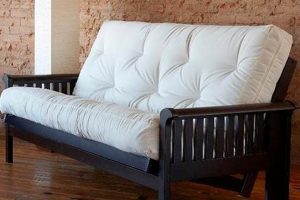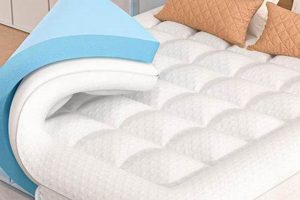The dimensions of a standard double bed are 54 inches in width and 75 inches in length. These measurements define the sleeping surface area that the bed provides. This size is commonly selected as a transition from a twin bed or when space is limited, providing a middle ground between single and larger options.
Understanding these measurements is important for selecting appropriate bedding, fitting the bed within a room, and ensuring sufficient space for comfortable sleep. Historically, this bed size became popular as it offers greater individual sleeping space than a twin without requiring the substantial room footprint of a queen or king-sized bed. Its practicality has made it a mainstay in guest rooms, smaller apartments, and for single sleepers desiring additional room.
The remainder of this article will delve deeper into considerations regarding these dimensions, including factors influencing bed selection and compatibility with various sleeping arrangements and body types. Further discussion will address practical considerations when purchasing such a bed, focusing on elements like frame selection and sheet fitting.
Considerations for Selecting a Double Bed
The following guidance offers critical factors to evaluate when determining if a double bed, characterized by its standardized dimensions, is the appropriate choice.
Tip 1: Room Dimensions: Prior to purchase, accurately measure the available space. Ensure adequate clearance around the bed for movement and the placement of additional furniture, such as nightstands or dressers.
Tip 2: Single Occupancy Comfort: This size is often suitable for single individuals desiring additional sleeping space compared to a twin. However, consider personal sleeping habits; individuals who frequently move or prefer a wider surface may benefit from a larger option.
Tip 3: Dual Occupancy Limitations: While theoretically accommodating two adults, the width may prove restrictive for long-term comfort. Evaluate shared sleeping styles and potential disturbances before opting for this size for couples.
Tip 4: Bedding Compatibility: Ensure proper fit when selecting sheets, comforters, and other bedding accessories. Verifying dimensions prevents ill-fitting linens, which can detract from comfort and aesthetics.
Tip 5: Frame Compatibility: The frame must be designed to support the dimensions. Inadequate support can lead to premature wear, discomfort, or structural damage.
Tip 6: Future Considerations: Project future needs. If planning to accommodate guests regularly or if expecting personal space requirements to evolve, a larger bed size may be a more pragmatic long-term investment.
Tip 7: Body Size: Assess compatibility with individual height and weight. Taller individuals may find the length insufficient, while those with broader frames may experience discomfort due to the width limitations.
Careful assessment of these factors will facilitate an informed decision regarding whether a double bed provides an optimal sleeping solution, promoting restorative rest and a comfortable living environment.
The subsequent sections of this article will explore the advantages and disadvantages of various bed sizes, further empowering readers to select the ideal sleeping surface based on individual needs and preferences.
1. 54-inch Width
The 54-inch width is a definitive characteristic of a standard double bed. This dimension dictates the space available for a sleeper, directly impacting comfort and the practicality of shared occupancy. The 54-inch span is a key component that defines the bed size, affecting the type of sheets required, the amount of space it occupies in a room, and its overall suitability for different individuals or couples. Without this width, a bed cannot be accurately classified as a standard double. The measurement serves as a fundamental baseline in mattress manufacturing and retail, allowing consumers to readily identify and compare bed sizes.
Consider a scenario where two adults attempt to share a bed with this width. The available sleeping space per person is considerably less than that offered by a queen or king-sized bed. This limited width can lead to disrupted sleep due to movements and potential discomfort if both individuals prefer a wider area. From a practical standpoint, understanding the 54-inch width is critical when purchasing fitted sheets. Sheets designed for larger mattresses will not fit properly, resulting in excess fabric and a less comfortable sleeping surface. Conversely, sheets intended for smaller beds will be too tight, potentially causing damage to the material or an inadequate fit.
In summary, the 54-inch width is an integral, non-negotiable aspect of the bed size. Its accurate comprehension enables informed purchasing decisions, optimized sleeping arrangements, and a better understanding of spatial requirements. Failure to recognize its significance can result in discomfort, ill-fitting accessories, and a suboptimal sleeping experience. The consideration of this measurement is therefore paramount when evaluating the suitability of a double bed for specific needs and preferences.
2. 75-inch Length
The 75-inch dimension establishes the longitudinal extent of a standard double bed, contributing directly to its suitability for occupants of varying heights. Its relationship to the overall bed size is fundamental, influencing comfort and the ability to achieve restorative sleep.
- Accommodation of Height
The 75-inch length determines the maximum height of an individual who can comfortably utilize this bed size. Individuals exceeding this height may experience discomfort due to their feet extending beyond the mattress edge, leading to disrupted sleep and potential musculoskeletal strain. As a guideline, individuals taller than approximately 6 feet (72 inches) may find this length insufficient.
- Spatial Considerations
This dimension influences the bed’s placement within a room. The 75-inch measurement contributes to the overall footprint of the bed, impacting available space for other furniture and movement. Accurate consideration of this length is critical for ensuring the bed fits comfortably within the room without creating obstructions or hindering accessibility.
- Bedding Selection
The 75-inch length is a key factor in selecting appropriately sized bedding. Sheets, comforters, and other accessories must be designed to accommodate this dimension to ensure proper fit and coverage. Using bedding intended for shorter mattresses can result in exposure and discomfort, while oversized bedding may appear cumbersome and aesthetically unappealing.
- Support and Frame Design
The frame supporting the mattress must be designed to adequately accommodate the 75-inch length. Insufficient support can lead to sagging, uneven weight distribution, and premature wear. Selecting a frame specifically designed for mattresses of this size is crucial for maintaining structural integrity and ensuring optimal comfort and longevity.
In summary, the 75-inch dimension plays a central role in determining the practicality and comfort of a standard double bed. Its implications extend beyond mere measurement, encompassing aspects of physical accommodation, spatial planning, bedding selection, and structural support. Considering this dimension is essential for selecting a bed that effectively meets individual needs and maximizes sleep quality.
3. Surface Area
The surface area of a standard double bed, directly derived from the dimensions designated as the defining characteristic of the “full mattress size in inches,” represents a quantifiable measure of available sleeping space. This area is a critical determinant in assessing suitability for both single and dual occupancy.
- Calculation of Sleeping Space
The surface area is calculated by multiplying the width (54 inches) by the length (75 inches), resulting in 4050 square inches. This figure represents the total space available for an individual or individuals to occupy during sleep. The derived area dictates the level of physical comfort attainable, especially concerning freedom of movement and proximity to a sleep partner.
- Single Occupancy Comfort and Limitations
For single sleepers, this surface area provides a moderate level of space. It exceeds the dimensions of a standard twin bed, allowing for greater freedom of movement and reduced feelings of confinement. However, individuals who prefer highly expansive sleeping arrangements may find the area restrictive compared to larger options such as queen or king-sized beds. The specific sleeping habits and physical size of the individual directly correlate with the perception of comfort derived from this surface area.
- Dual Occupancy Considerations and Restrictions
The 4050 square inches represents a limited sleeping space when shared between two individuals. The available area per person is significantly reduced, potentially leading to disrupted sleep patterns and discomfort due to proximity. This configuration is often considered a temporary or occasional solution rather than a long-term arrangement for couples. Factors such as individual sleeping styles, body size, and sensitivity to movement contribute to the overall suitability of this configuration.
- Comparative Analysis with Other Bed Sizes
The surface area offers a point of comparison with alternative bed sizes. A queen-sized bed provides a larger surface area, offering increased comfort for both single and dual occupancy. A king-sized bed represents an even greater expansion of available sleeping space. Analyzing the differences in surface area assists in determining the optimal bed size based on individual needs and preferences. The “full mattress size in inches” sits between single and queen-sized bed, offering a compromise on space and room size.
The surface area, intrinsically linked to the “full mattress size in inches,” provides essential data for evaluating the suitability of this particular bed configuration. Its calculation informs decisions based on individual needs, sleeping habits, and spatial constraints, ultimately influencing the quality of sleep and overall satisfaction with the chosen sleeping arrangement.
4. Sleeping Space
The concept of “sleeping space” is fundamentally determined by the dimensions associated with a standard double bed. These measurements, defining the “full mattress size in inches,” directly impact the comfort and suitability of the bed for both single sleepers and couples. A smaller “full mattress size in inches” will reduce space to sleep. The 54-inch width and 75-inch length translate into a finite area for rest, influencing the freedom of movement, the ability to stretch out comfortably, and the degree of disturbance experienced when sharing the bed. For example, a single adult of average build will find sufficient room, while two adults may experience limitations in their individual sleeping zones, potentially leading to restless nights.
The importance of adequate “sleeping space” is underscored by its direct effect on sleep quality. Restricted room to move can result in discomfort, increased pressure points, and frequent awakenings. Consider the scenario of a person who tends to toss and turn during sleep; the limited width afforded by this size can lead to unintentionally disturbing a sleeping partner or even falling off the edge. Therefore, understanding the correlation between the specific “full mattress size in inches” and the resulting sleeping space is essential for making an informed purchase. This knowledge allows potential buyers to evaluate whether the available area will adequately meet their individual or shared sleeping requirements.
In summary, the “full mattress size in inches” predetermines the available “sleeping space,” a critical factor in achieving restorative sleep. The limited sleeping surface poses challenges for couples or individuals who prefer expansive sleeping areas. A clear understanding of this relationship enables individuals to assess whether this particular bed size aligns with their personal needs, ensuring a comfortable and undisturbed sleep experience.
5. Room Footprint
The spatial area occupied by a bed, commonly referred to as its “room footprint,” is directly determined by its dimensions. In the context of a double bed, the “full mattress size in inches” dictates the amount of floor space the bed will consume, a crucial consideration in room planning and interior design.
- Physical Dimensions and Area Calculation
The room footprint is a direct result of multiplying the width and length, which are fixed when referring to the “full mattress size in inches.” With standardized measurements of 54 inches in width and 75 inches in length, the bed occupies a rectangular area of 4050 square inches. This calculation informs spatial planning, determining the amount of unobstructed floor space remaining.
- Influence on Room Layout and Functionality
The bed significantly impacts the overall layout of a room. Once the room footprint is established, decisions regarding placement of additional furniture, such as nightstands, dressers, and seating, are contingent upon the remaining space. In smaller rooms, the size may constrain furniture choices and potentially limit functionality. This consideration is particularly important in urban apartments or guest rooms where space is at a premium.
- Impact on Traffic Flow and Accessibility
The bed can impede movement within a room. Careful consideration of the bed’s room footprint is necessary to ensure clear pathways for walking and accessibility to closets, doors, and windows. Inadequate planning can result in congested spaces that hinder daily activities. Strategic placement and awareness of clearances around the perimeter are essential for optimizing usability.
- Relationship to Room Size and Proportions
The room footprint should be proportionate to the room’s overall dimensions. A double bed may appear disproportionately large in a small room, creating a sense of confinement. Conversely, it may seem insignificant in an expansive space, leaving the room feeling empty. Maintaining visual balance by selecting appropriate furniture and decor helps to mitigate potential discrepancies in scale.
Consideration of room footprint, intrinsically linked to the “full mattress size in inches,” is pivotal in effective room planning. This awareness facilitates optimal use of available space, ensures comfortable movement, and contributes to overall aesthetic harmony. Ignoring the relationship between the bed’s dimensions and the surrounding environment can lead to dysfunctional spaces and compromised living quality.
Frequently Asked Questions
The following section addresses common inquiries regarding the dimensions of standard double beds. These answers provide clarity on the practical implications and usage scenarios associated with this specific mattress size.
Question 1: What are the precise measurements associated with a full mattress size in inches?
A standard double bed measures 54 inches in width and 75 inches in length. These figures represent the nominal dimensions; slight variations may occur due to manufacturing tolerances.
Question 2: Is a full mattress size in inches suitable for couples?
While technically accommodating two adults, the limited width may prove restrictive for long-term comfort. Consider individual sleeping habits and preferences when assessing suitability for dual occupancy.
Question 3: What bedding sizes are appropriate for a full mattress size in inches?
Bedding specifically labeled “full” or “double” is designed to fit these dimensions. Ensure precise measurements when purchasing fitted sheets to avoid ill-fitting linens.
Question 4: How does a full mattress size in inches compare to a queen-sized mattress?
A queen-sized mattress is larger, typically measuring 60 inches in width and 80 inches in length. This increased size provides greater sleeping space, particularly advantageous for couples.
Question 5: What is the recommended room size for a full mattress size in inches?
While a specific room size cannot be definitively prescribed, a minimum room dimension of 10 feet by 10 feet is generally recommended to allow adequate space for the bed and other essential furniture.
Question 6: What are the key considerations when selecting a frame for a full mattress size in inches?
Ensure the frame is specifically designed to support the weight and dimensions. Verify that the frame provides adequate center support to prevent sagging and premature wear.
This FAQ has addressed common questions concerning the specific dimensions and associated considerations with “full mattress size in inches.” It is advisable to consult specific product specifications prior to purchase to account for individual variations.
The next section will provide a concise summary of the benefits and drawbacks associated with selecting this bed size.
Conclusion
This article has systematically explored the dimensions, implications, and practical considerations associated with a standard double bed, focusing primarily on the specific “full mattress size in inches.” Key aspects examined included the precise measurements, suitability for single and dual occupancy, appropriate bedding selection, spatial implications, and comparative analysis with alternative bed sizes. The discussion has illuminated the advantages and limitations inherent in selecting a bed defined by these fixed dimensions.
The data presented underscores the importance of informed decision-making when choosing a sleeping surface. While the “full mattress size in inches” may offer a viable solution in specific circumstances, careful evaluation of individual needs, sleeping habits, and room constraints remains paramount. Recognizing the limitations and maximizing the benefits requires a comprehensive understanding of its quantifiable attributes and their resultant impact on comfort and overall sleep quality. Future purchasers should utilize this knowledge to ensure their selection aligns with their requirements, contributing to a restorative and optimized sleep experience.


![Best 48 Inch Wide Mattress [Guide] Size & Comfort! Organic & Natural Mattress Buyer’s Guide: Non-Toxic Sleep Solutions Best 48 Inch Wide Mattress [Guide] Size & Comfort! | Organic & Natural Mattress Buyer’s Guide: Non-Toxic Sleep Solutions](https://mattressworldpa.com/wp-content/uploads/2025/07/th-3677-300x200.jpg)
![Best 6 Inch Twin Memory Foam Mattress [Guide & Review] Organic & Natural Mattress Buyer’s Guide: Non-Toxic Sleep Solutions Best 6 Inch Twin Memory Foam Mattress [Guide & Review] | Organic & Natural Mattress Buyer’s Guide: Non-Toxic Sleep Solutions](https://mattressworldpa.com/wp-content/uploads/2025/07/th-3676-300x200.jpg)



